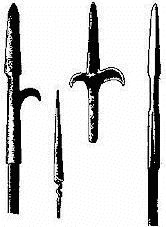Chapter 10: The Hangover
Pikes: The Newest Adoption of the Tawantinsuyu
The victory over the Spanish was a large one for the Tawantinsuyu, with more men captured and gunpowder seized to argument the rapidly depleting supply. New Iron, new guns, all helped the empire's strength grow more. However problems brewed beneath the surface of the advances. Figuring out gunpowder was going slowly as Conquistadors had simply acquired it from elsewhere. Knowledge of how to make Iron was vaguely acquired, find ore and heat it up, but steel working and good iron making was still a ways off.
Atahualpa's generals were quick to grasp the concept of a pike square, and how useful they could be against calvary charges. In addition they required less iron then swords. Training the army, wholly unused to formation based warfare, was tricky but the principles of pike warfare were appearing rapidly in the Empire.
The army returned to the south, beginning the process of integrating the new gains into the empire. Mapuche tribes still lived on the edges of the empire, scraping out a life with their backs against the desert. Raids were common as Tawantinsuyu control was focused only on population hubs and resources the Empire could use. Control over the far south was proving nominal as events to the north transpired.
Alvarado had brought Influenza and it swept south with a fiery vengeance hitting an Empire still facing a huge population drop from the ongoing smallpox epidemic. Andagoya had not brought anything directly, but Spanish landings north of the Empire brought measles and soon that to hit the Tawantinsuyu. The death toll was catastrophic, most areas having their populations more then halved. Some localities were able to quarantine themselves and bear the crisis well, but the diseases moved quickly and often were carried by messengers across the mountains. The coastal areas were hit the hardest, with no geographic boundaries to slow the disease the coast was covered with the dead quickly. Quito, having suffered greatly already, was the hardest hit of the cities, with Influenza hitting the city as it tried to recover from Alvarado's brutal occupation. Even the presence of the Son of Inti could not stop the plague as his army, by now at Cajamarca, died in droves.
Francisco de Orellana, a captured follower of Alvarado, would describe the frantic efforts to quarantine Quito as a siege in his famed book "Voyage to the South". The city would manage to avoid the plagues for some time, but nothing could stop the diseases forever and soon even the greatest city in the empire saw its citizens dying in droves, though it had already been hit by smallpox[1].
The plagues severely reduced the production of the communal farms that dominated the empire with even those who survived often being unable to work in the fields. Harvests failed across the empire. Human sacrifices rose to a number unseen in living memory in an attempt to end the suffering, but to no avail. The system of storehouses would keep many fed in the greatest famine anyone had ever seen, but choices had to be made in many areas about who was to be given food. As food was taken from the countryside to the cities the Tawantinsuyu met something that their Spanish "guests" knew all too well. The peasant uprising. No massive overturning of power, even local, occurred in these rebellions that were often just glorified riots, but they were a break from the well managed empire of the pre-contact era. Storehouses were raided by gangs seeking to feed themselves and mobs forced messengers away from way stations, wanting to keep the food for locals. Such revolts were generally crushed easily by local forces loyal to the empire, but showed a genuine destabilization of the state.
With the army pacifying the south and putting down revolts in the heartland the fringes of the empire began to fray. The tribes of the far north, forced to a settlement by Atahualpa, commenced incursions into the lands they had abandoned. Though plague stricken themselves they did not face the daunting task of holding a huge nation together and struck whenever they could find a segment for the army without new weaponry. The coast saw bandits rove for power. Supplies for forces in the jungle dried up and they found themselves under siege by an unseen enemy. With such a wide array of problems and an apparatus paralyzed Atahualpa was forced to make decisions on where to spend effort to stabilize his empire. The Sapa Inka found himself ignoring riots on the northern coast to fight raids on the iron mines to the south. Minor incidents that would have been crushed before contact had to be left unsolved in favor of larger issues. At its best this policy meant local autonomy grew, at its worst it meant that parts of the empire ceased to be controlled except while the Army was there.
Atahualpa also relied on the severely culled royal family more, despite (or perhaps because of) their Cusco power base being different then his northern supporters. This was due to an emerging wariness of the power his generals had assumed. Atahualpa did not fear his generals but he did not want to set a precedent for his successors where men not from the brood of the Sun could dominate the Tawantinsuyu. Manco Capac proved an able supporter of his half brother and rose to prominence, though always kept away from Cusco for fear of another Machu Picchu rebellion. Manco Capac would cultivate a following in the south and become a patron of iron working in all its forms.
And so the Tawantinsuyu shambled on. The Empire stood at both its most powerful state and its weakest in a long time. The Sapa Inka awaited the return of the Spanish with a tired heart, ready to fight the next battle in a seemingly endless war.
_____
1: Way back in Chapter 1.

